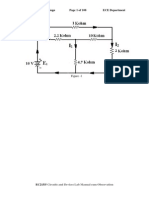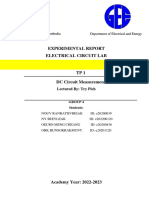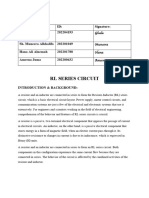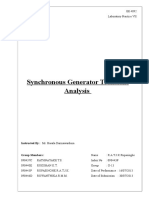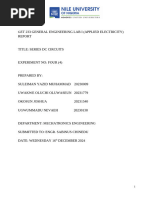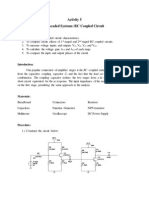ECE 151 Lab 5
Uploaded by
Judy Ann Bernalte VargasECE 151 Lab 5
Uploaded by
Judy Ann Bernalte VargasECE 151 Fundamentals of Electronic Instrumentation
Name
Judy Ann B. Vargas
Date Performed
LAB 4
October 21, 2015
AC VOLTAGE & MEASUREMENT
Objectives
1. To learn the method and technique of measurement.
2. To measure the resistance and AC voltages.
Apparatus
Resistors
Multi-meter
Function Generator
Oscilloscope
Breadboard
Jumper Wire
Procedure
Part A
1. You are given a set of resistors. By using multi-meter, measure the resistance value and record
the reading in Table 1. Calculate the percentage error for each measurement and compare to
actual value using color code.
Part B
2. Construct a circuit as in Figure 1.
Figure 1
ECE 151 Fundamentals of Electronic Instrumentation
LAB 4
3. Apply AC input signal as indicate in Figure 1. Connect Channel 1 of oscilloscope to the input
signal and observe the output voltage Va and Vb using Channel 2. Measure and record the values
in Table 2.
4. Increase the amplitude of input signal of Channel 1 (refer Table 3 increment) and observe the
Voltage of Va and Vb and with your own word, make some discussion.
*Show all calculations in additional pages.
Data Table
Resistance Measurement
TABLE 1
Resistor
Measured
Color Code
% Error
R1
2.16 k
2.2 k
1.82%
R2
1.254 k
1.36 k
7.79%
R3
4.62 k
4.7 k
1.70%
R4
0.994 k
1 k
0.60%
Voltage Measurement
TABLE 2
Voltage
Measured Value
Calculated Value
% Error
Va
0.700 V
0.644 V
8.70%
Vb
0.580 V
0.530 V
9.43%
ECE 151 Fundamentals of Electronic Instrumentation
LAB 4
Increase Input Voltage
TABLE 3a: Voltage, Va
Input Voltage, Vp-p
Measured Value
Calculated Value
% Error
1.44 V
1.287 V
11.89%
2.80 V
2.575 V
8.74%
15
5.20 V
4.828 V
7.71%
16
5.40 V
5.149 V
4.87%
TABLE 3b: Voltage, Vb
Input Voltage, Vp-p
Measured Value
Calculated Value
% Error
1.20 V
1.060 V
13.20%
2.4 V
2.118 V
13.31%
15
4.40 V
3.973 V
10.75%
16
4.60 V
4.237 V
8.57%
Discussion/Analysis
As seen in the table above, we can see that as the amplitude is increased, the values of Va
and Vb also increases. Since the AC voltage changes values from time to time, unlike the DC
voltage which remains steady in time, it is difficult to point out the exact measurement. In the
experiment, we used the oscilloscope to be able to measure the voltages in the circuit. The value
of the voltage we chose to show is the peak-to-peak voltage or the total voltage from the positive
peak to the negative peak. Because the values changes, it is best to get the peak-to-peak values
because it mostly remains the same throughout the whole duration. Another value of the voltage
can be considered good to use is the root mean square or RMS voltage. Because of the changes
ECE 151 Fundamentals of Electronic Instrumentation
LAB 4
in values from the positive peak to the negative peak, it is really difficult to get the real effect of
the voltage. The RMS value is the effective value of the varying voltage. Therefore, this value is
somewhat the equivalent value if we measure it in DC. The peak-to-peak and RMS value of the
voltage is related as seen in the formula:
= 1.4
Calculations
Percentage Error for R1
% =
| |
|2.2 2.16 |
100 =
100 = 1.82%
2.2
Percentage Error for R2
% =
| |
|1.36 1.254 |
100 =
100 = 7.79%
1.36
Percentage Error for R3
% =
| |
|4.7 4.62 |
100 =
100 = 1.70%
4.7
Percentage Error for R4
% =
| |
|1 0.994 |
100 =
100 = 0.60%
1
ECE 151 Fundamentals of Electronic Instrumentation
LAB 4
By KVL at Loop 1:
+ 1 1 + 2 (1 2 ) = 0
1 (1 + 2 ) 2 2 =
1 (3.414 ) 2 (1.254 ) =
1 =
+ 2 (1.254 )
3.414
(1)
By KVL at Loop 2:.6
2 (2 1 ) + 3 2 + 4 2 = 0
2 1 + 2 (2 + 3 + 4 ) = 0
1 (1.254 ) + 2 (6.868 ) = 0
(2)
= 1.254 (1 2 ) (3)
= 2 (4.62 ) (4)
Substituting (1) to (2)
2 (1.254 )
(
) (1.254 ) (
) (1.254 ) + 2 (6.868 ) = 0
3.414
3.414
2 (1.254 )
(
) (1.254 ) + 2 (6.868 ) = (
) (1.254 )
3.414
3.414
6.407 (2 ) =
209
569
2 = 5.733105
(5)
When Vpp = 2V, using equations (1) and (5) to get the currents and (3) and (4) for the voltage:
2 = 5.733105
2 = 5.733105 (2)
2 = 1.147104
ECE 151 Fundamentals of Electronic Instrumentation
1 =
1 =
LAB 4
+ 2 (1.254 )
3.414
2 + 1.147104 (1.254 )
3.414
1 = 6.279104
= 1.254 (1 2 )
= 1.254 (6.279104 1.147104 )
= 0.644
= 2 (4.62 )
= (1.147104 )(4.62 )
= 0.530
% =
| |
|0.644 0.700|
100 =
100 = 8.70%
0.644
% =
| |
|0.530 0.580|
100 =
100 = 9.43%
0.530
When Vpp = 4V, using equations (1) and (5) to get the currents and (3) and (4) for the voltage:
2 = 5.733105
2 = 5.733105 (4)
2 = 2.293104
1 =
1 =
+ 2 (1.254 )
3.414
4 + 2.293104 (1.254 )
3.414
ECE 151 Fundamentals of Electronic Instrumentation
LAB 4
1 = 1.256103
= 1.254 (1 2 )
= 1.254 (1.256103 2.293104 )
= 1.287
= 2 (4.62 )
= (2.293104 )(4.62 )
= 1.060
% =
| |
|1.287 1.44|
100 =
100 = 11.89%
1.287
% =
| |
|1.060 1.20|
100 =
100 = 13.20%
1.060
When Vpp = 8V, using equations (1) and (5) to get the currents and (3) and (4) for the voltage:
2 = 5.733105
2 = 5.733105 (8)
2 = 4.586104
1 =
+ 2 (1.254 )
3.414
8 + 4.586104 (1.254 )
1 =
3.414
1 = 2.512103
= 1.254 (1 2 )
ECE 151 Fundamentals of Electronic Instrumentation
LAB 4
= 1.254 (2.512103 4.586104 )
= 2.575
= 2 (4.62 )
= (4.586104 )(4.62 )
= 2.118
% =
| |
|2.575 2.80|
100 =
100 = 8.74%
2.575
% =
| |
|2.118 2.40|
100 =
100 = 13.31%
2.118
When Vpp = 15V, using equations (1) and (5) to get the currents and (3) and (4) for the voltage:
2 = 5.733105
2 = 5.733105 (15)
2 = 8.599104
1 =
1 =
+ 2 (1.254 )
3.414
15 + 8.599104 (1.254 )
3.414
1 = 4.710103
= 1.254 (1 2 )
= 1.254 (4.710103 8.599104 )
= 4.828
ECE 151 Fundamentals of Electronic Instrumentation
LAB 4
= 2 (4.62 )
= (8.599104 )(4.62 )
= 3.973
% =
| |
|4.828 5.20|
100 =
100 = 7.71%
4.828
% =
| |
|3.973 4.40|
100 =
100 = 10.75%
3.973
When Vpp = 16V, using equations (1) and (5) to get the currents and (3) and (4) for the voltage:
2 = 5.733105
2 = 5.733105 (16)
2 = 9.172104
1 =
1 =
+ 2 (1.254 )
3.414
16 + 9.172104 (1.254 )
3.414
1 = 5.023103
= 1.254 (1 2 )
= 1.254 (5.023103 9.172104 )
= 5.149
= 2 (4.62 )
= (9.172104 )(4.62 )
= 4.237
ECE 151 Fundamentals of Electronic Instrumentation
% =
| |
|5.149 5.40|
100 =
100 = 4.87%
5.149
% =
| |
|4.237 4.60|
100 =
100 = 8.57%
4.237
10
LAB 4
You might also like
- Experiment #01 (Measurement of AC Voltage With An Oscilloscope)No ratings yetExperiment #01 (Measurement of AC Voltage With An Oscilloscope)9 pages
- EC 2155 - Circuits and Devices Lab Manual Cum ObservationNo ratings yetEC 2155 - Circuits and Devices Lab Manual Cum Observation108 pages
- Devices Experiment 1 - Inverting and Non-Inverting100% (1)Devices Experiment 1 - Inverting and Non-Inverting16 pages
- Laboratory Report: Basic Circuits & Systems LaboratoryNo ratings yetLaboratory Report: Basic Circuits & Systems Laboratory7 pages
- E104 - Superposition Theorem and LinearityNo ratings yetE104 - Superposition Theorem and Linearity19 pages
- Exp - 1 - Midterm - Nodal Analysis of AC CircuitsNo ratings yetExp - 1 - Midterm - Nodal Analysis of AC Circuits4 pages
- Superposition Theorem: Faculty of Engineering-Electrical and Computer Engineering DepartmentNo ratings yetSuperposition Theorem: Faculty of Engineering-Electrical and Computer Engineering Department5 pages
- Sample Questions For Testing Methods Final ExamsNo ratings yetSample Questions For Testing Methods Final Exams5 pages
- Servo Drive Systems - Chapter 4 - Part1No ratings yetServo Drive Systems - Chapter 4 - Part120 pages
- Energy Conversion I: Topic 2: Transformers & Its Performance (S. Chapman, Ch. 2)No ratings yetEnergy Conversion I: Topic 2: Transformers & Its Performance (S. Chapman, Ch. 2)12 pages
- Verification of Thevenin'S Theorem & Maximum Power Transfer: Eeen 311 Experiment 1No ratings yetVerification of Thevenin'S Theorem & Maximum Power Transfer: Eeen 311 Experiment 19 pages
- 090443P - Synchronous Generator Transient AnalysisNo ratings yet090443P - Synchronous Generator Transient Analysis16 pages
- Lab #2 Ac Measurements: EE 200 - Electronic Circuits ImplementationNo ratings yetLab #2 Ac Measurements: EE 200 - Electronic Circuits Implementation8 pages
- CO2038_Lab5_CCO3_2352821_Đặng Duy Nguyên (1)No ratings yetCO2038_Lab5_CCO3_2352821_Đặng Duy Nguyên (1)24 pages
- Experimentation, Validation, and Uncertainty Analysis for EngineersFrom EverandExperimentation, Validation, and Uncertainty Analysis for EngineersNo ratings yet
- Student Solutions Manual to Accompany Loss Models: From Data to Decisions, Fourth EditionFrom EverandStudent Solutions Manual to Accompany Loss Models: From Data to Decisions, Fourth Edition4/5 (1)
- Signals and Control Systems: Application for Home Health MonitoringFrom EverandSignals and Control Systems: Application for Home Health MonitoringNo ratings yet
- Activity 5 Cascaded Systems: RC Coupled Circuit: ObjectivesNo ratings yetActivity 5 Cascaded Systems: RC Coupled Circuit: Objectives5 pages
- Procedure: Halfwave Rectifier (Positive Series Clipper)No ratings yetProcedure: Halfwave Rectifier (Positive Series Clipper)5 pages
- Over Head Transmission Line Fault Detection100% (1)Over Head Transmission Line Fault Detection9 pages
- Unit 4 Governing Equations of Heat Conduction: StructureNo ratings yetUnit 4 Governing Equations of Heat Conduction: Structure45 pages
- Chapter 4 - Non-Uniform Flow in Open ChannelNo ratings yetChapter 4 - Non-Uniform Flow in Open Channel140 pages
- What Is The Momentum of A 23 KG Cannon Shell Going 530 MNo ratings yetWhat Is The Momentum of A 23 KG Cannon Shell Going 530 M13 pages
- Hybrid Beamforming For DFRC System Based On SINR Performance MetricNo ratings yetHybrid Beamforming For DFRC System Based On SINR Performance Metric6 pages
- Experiment #01 (Measurement of AC Voltage With An Oscilloscope)Experiment #01 (Measurement of AC Voltage With An Oscilloscope)
- EC 2155 - Circuits and Devices Lab Manual Cum ObservationEC 2155 - Circuits and Devices Lab Manual Cum Observation
- Devices Experiment 1 - Inverting and Non-InvertingDevices Experiment 1 - Inverting and Non-Inverting
- Laboratory Report: Basic Circuits & Systems LaboratoryLaboratory Report: Basic Circuits & Systems Laboratory
- Superposition Theorem: Faculty of Engineering-Electrical and Computer Engineering DepartmentSuperposition Theorem: Faculty of Engineering-Electrical and Computer Engineering Department
- Energy Conversion I: Topic 2: Transformers & Its Performance (S. Chapman, Ch. 2)Energy Conversion I: Topic 2: Transformers & Its Performance (S. Chapman, Ch. 2)
- Verification of Thevenin'S Theorem & Maximum Power Transfer: Eeen 311 Experiment 1Verification of Thevenin'S Theorem & Maximum Power Transfer: Eeen 311 Experiment 1
- 090443P - Synchronous Generator Transient Analysis090443P - Synchronous Generator Transient Analysis
- Lab #2 Ac Measurements: EE 200 - Electronic Circuits ImplementationLab #2 Ac Measurements: EE 200 - Electronic Circuits Implementation
- Experimentation, Validation, and Uncertainty Analysis for EngineersFrom EverandExperimentation, Validation, and Uncertainty Analysis for Engineers
- Student Solutions Manual to Accompany Loss Models: From Data to Decisions, Fourth EditionFrom EverandStudent Solutions Manual to Accompany Loss Models: From Data to Decisions, Fourth Edition
- Signals and Control Systems: Application for Home Health MonitoringFrom EverandSignals and Control Systems: Application for Home Health Monitoring
- Mechanical Vibrations: Applications to EquipmentFrom EverandMechanical Vibrations: Applications to Equipment
- Activity 5 Cascaded Systems: RC Coupled Circuit: ObjectivesActivity 5 Cascaded Systems: RC Coupled Circuit: Objectives
- Procedure: Halfwave Rectifier (Positive Series Clipper)Procedure: Halfwave Rectifier (Positive Series Clipper)
- Unit 4 Governing Equations of Heat Conduction: StructureUnit 4 Governing Equations of Heat Conduction: Structure
- What Is The Momentum of A 23 KG Cannon Shell Going 530 MWhat Is The Momentum of A 23 KG Cannon Shell Going 530 M
- Hybrid Beamforming For DFRC System Based On SINR Performance MetricHybrid Beamforming For DFRC System Based On SINR Performance Metric


